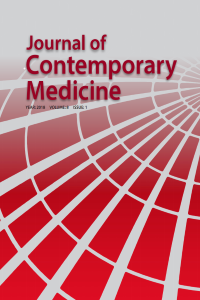Trombosit Büyük Hücre Oranı (P-LCR) Düzeylerine Göre İnmenin Ayırıcı Tanısı
Trombosit Büyük Hücre Oranı, İnme, İskemik, Hemorajik, Geçici İskemik Atak
Differential Diagnosis of Stroke by Platelet Large Cell Ratio (P-LCR) Levels
Platelet Large Cell Ratio, stroke, ischemic, hemorrhagic, Transient ischemic attack,
___
- Simon RS, Aminoff AJ, Greenberg DA. Clinical Neurology, 10th edition. . McGraw-Hill Education. 2018
- Choi D-H, Kang S-H, Song H. Mean platelet volume: a potential biomarker of the risk and prognosis of heart disease. Korean J Intern Med. 2016;31(6):1009-17.
- Sadeghi F, Kovács S, Zsóri KS, Csiki Z, Bereczky Z, Shemirani AH. Platelet count and mean volume in acute stroke: a systematic review and meta-analysis. Platelets. 2019:1-9.
- Ranjith MP, DivyaRaj R, Mathew D, George B, Krishnan MN. Mean platelet volume and cardiovascular outcomes in acute myocardial infarction. Heart Asia. 2016;8(1):16-20.
- Park Y, Schoene N, Harris W. Mean platelet volume as an indicator of platelet activation: methodological issues. Platelets. 2002;13(5-6):301-6.
- Grotto HZW, Noronha JFA. Platelet larger cell ratio (P-LCR) in patients with dyslipidemia. Clinical & Laboratory Haematology. 2004;26(5):347-9.
- Rechciński AJT, Foryś J, Krzemińska-Pakuła M, et al. Prognostic value of platelet indices after acute myocardial infarction treated with primary percutaneous coronary intervention. Cardiol J 2013;20(5):491-8.
- Dehghani MR, Taghipour-Sani L, Rezaei Y, Rostami R. Diagnostic importance of admission platelet volume indices in patients with acute chest pain suggesting acute coronary syndrome. Indian Heart J. 2014;66(6):622-8.
- Reeves MJ, Bushnell CD, Howard G, et al. Sex differences in stroke: epidemiology, clinical presentation, medical care, and outcomes. Lancet Neurol. 2008;7(10):915-26.
- Haast RAM, Gustafson DR, Kiliaan AJ. Sex differences in stroke. J Cereb Blood Flow Metab. 2012;32(12):2100-7.
- Girijala RL, Sohrabji F, Bush RL. Sex differences in stroke: Review of current knowledge and evidence. Vascular Medicine. 2016;22(2):135-45.
- Khandekar MM, Khurana AS, Deshmukh SD, Kakrani AL, Katdare AD, Inamdar AK. Platelet volume indices in patients with coronary artery disease and acute myocardial infarction: an Indian scenario. Journal of Clinical Pathology. 2006;59(2):146.
- Cerit L, Cerit Z. Relationship between coronary tortuosity and plateletcrit coronary tortuosity and plateletcrit. Cardiovasc J Afr. 2017;28(6):385-8.
- De Luca G, Santagostino M, Secco GG, et al. Platelet-Large Cell Ratio and the extent of coronary artery disease: results from a large prospective study. Journal of Thrombosis and Thrombolysis. 2010;30(4):426-33.
- Verdoia M, Barbieri L, Schaffer A, et al. Platelet–larger cell ratio and the risk of periprocedural myocardial infarction after percutaneous coronary revascularization. Heart and Vessels. 2015;30(1):20-7.
- Yayın Aralığı: Yılda 6 Sayı
- Başlangıç: 2011
- Yayıncı: Rabia YILMAZ
Testis Tümörleri: 15 Yıllık Arşiv Taraması ve Histopatolojik Değerlendirilmesi
Akgül ARICI, Elif AKÇAY, Mümine GÖRMEZ, Faik DERESOY, Fikret ERDEMİR, Reşit KÖSEOĞLU
Muhammet Ali VARKAL, Mustafa ÖZÇETİN, Ayşe KILIÇ
Pandemi Sürecinde Juvenil ve Adolesanlarda Kifoz ve Skolyoz Cerrahisi Deneyimlerimiz
Bengü TUMAN, Betül ŞEREFLİCAN, Taha Can TUMAN
Angina Pektoris Hastalarında B-Tipi Natriüretik Peptit ve Kalsiyum Skoru
Özlem ÖZBEK, Hüseyin Oğuz CAYMAZ
Sanem Aslıhan AYKAN, Dudu ÇELİK TAM, Tuğba ÖZSOY ÜNÜBOL, Hilmi KILAÇ, Halil UÇAN, Meltem DALYAN
Aksaray'da çocuk zehirlenmesinin araştırılması
Emine ÖZDEMİR KAÇER, İlker KAÇER, Hanife Tuğçe ÇAĞLAR
Orhan COŞKUN, Mustafa ÇAPRAZ, Zeynep ÇETİN
Türkiye’de Bireylerin COVID-19 Pandemisi Korkusu ve Kontrol Algılarının Karşılaştırılması
